Home
Vessels & Platters
Ornaments
Pens
Miscellaneous Turnings
Lidded Boxes
Bowls
Articles/Demos/Classes
Links
About Kurt
Contact Kurt
KurtHertzog.com
Making your own Carbide Tool
by Kurt Hertzog
Why a carbide tool?
The search for the perfect woodturning tool steel has mistakenly taken some to believe that carbide turning tools are the "answer"
because they don't need to be sharpened as often as a traditional turning tool steel. This search is usually by those who
can't sharpen their tools well or have a difficult time doing so. Their search is for the tool steel that will cut
well for the longest time and require the least amount of sharpening. Carbide tools really only fill one of these needs. Carbide cutting tools,
when used in woodturning, rarely require sharpening. However, they really don't cut that well. A properly sharpened carbon steel or
high speed steel tool will cut much better than a carbide tool ever will. These traditional tool steels require sharpening based on their use but they can take
and hold an edge that carbide is incapable of attaining.
If the traditional carbon steel, high speed steel, or the various PM alloy steels are more capable edge holding materials,
what advantage would carbide turning tools have? The best use I can find for carbide edged woodturning tools is as a scraper for hard
or abrasive, non-wood materials. I use various inlay materials in my turnings and find that the combination of inlay materials, usually stone or
metals, and the Cyanoacrylate glues bonding them makes a very tough cutting situation. After making the inlay proud of the finished surface, the
excess needs to be removed. While this can be cut or scraped with the traditional woodturning tool steels, it is extremely abusive of the
edge. This is where the carbide tool excels. The need is for a "tough" edge, not necessarily and extremely sharp edge. Carbide tools
also work well as scrapers for materials such as Corian. Corian and many of the other solid surface materials, because of their composition, can
be very tough on a cutting edge.
There are many different carbide cutters available for the metal cutting industry ranging from the carbide edged tool bits in various
sizes to a large assortment of cutter inserts of different sizes, shapes, and capabilities. While you could fabricate a tool that would
accept some of these different cutters, I find the round, square, or triangular replacement carbide inserts to be the easiest to work with.
These are available in a dizzying array of sizes, shapes, and function. You can find a tremendous selection via the internet from machine tool
supply companies or through your local suppliers. Enco or their parent MSC have a good selection and are readily available to the home
hobbiest.
Below is a quick pictorial on one method of making a simple scraper using a replaceable carbide cutting insert. You can use the square, round, or
triangular carbide inserts, depending on your desired application. Sharpening carbide requires special
wheels so it is usually beyond the reach of most of us. These inserts are made to be a low cost, throw away items so sharpening is not an issue. Buy
it, use it, and when it's too dull for your needs, rotate it to a fresh edge. When you are out of new edges, replace the insert. They are modestly
priced and with the toughness of the edge, you'll get surprisingly good life out of each edge when used in this type of application.
Click on thumbnail to view full size image
|
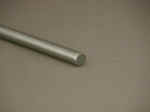
|
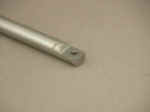
|
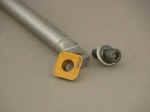
|
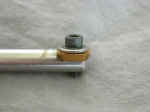
|
Use a piece of cold rolled or tool steel for the shaft. It can be round or square. A handle can be installed as desired. |
Grind or file a flat on the shaft. If square, the flat might want to be across the diagonal. Drill and tap for the appropriate size screw for your carbide insert. |
Use a carbide cutter insert for a replaceable carbide cutting tool along with a washer and screw. |
The carbide cutter is fully supported yet has enough relief to allow for scraping or shear cutting. |
|
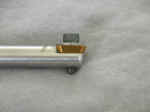
|
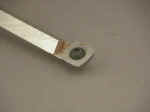
|
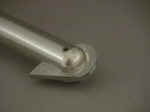
|
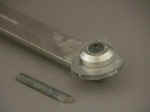
|
When the cutter is dull, loosen the screw and rotate the cutter to one of the other available cutter faces. |
The inspiration for this came from the Sorby shear scraping tool. I wanted to replace their cutter with a carbide but their screw size is too large. |
It should be obvious but this idea applies to square cutters, round cutters, threading cutters, or the like. |
Here is a Sorby tool that uses a scraper or tool bit. The tool bit can be replaced with a carbide cutter or carbide tipped cutter. |
| |
|
|
|
Photos by Kurt Hertzog |
|
|
|
Home
Vessels & Platters
Ornaments
Pens
Miscellaneous Turnings
Lidded Boxes
Bowls
Articles/Demos/Classes
Links
About Kurt
Contact Kurt
KurtHertzog.com







